|
TAROT
card meanings & free reading
|
Tarot vs. Playing Cards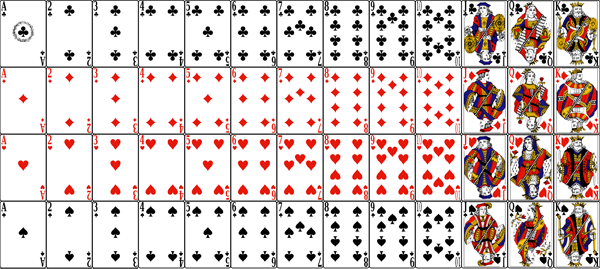
Similarities and DifferencesTarot is the extended deck of cards, usually 78, used for divination, whereas the modern playing card deck has 52 regular cards — Jokers excluded. They have the same roots, which are actually Chinese.
The playing card is a Chinese invention, documented already in the 9th century. The actual Tarot appeared in Europe around 1440, also at first for card games. Our modern deck of playing cards has the same origin. By time the two decks developed differently, according to use. The use of the decks for divination, cartomancy, commenced already in the 16th century and grew during the following centuries. That's just about the only use today of the Tarot deck, whereas the playing cards are sometimes used for divination but mostly for card games. Here's a substantial text on Tarotpedia about Tarot history. And here is the Wikipedia text about the playing card history.
Major and Minor ArcanaThe Tarot deck is divided into two groups of cards — the Major Arcana of 22 cards and the Minor Arcana (also called Lesser Arcana) of 56 cards. The Minor Arcana is also divided into four suits: Wands, Pentacles, Cups, and Swords, with 14 cards in each suit.The playing card deck is almost the same as the Tarot Minor Arcana, but with four cards missing: the Page of each suit. The playing card deck and Tarot share the Knight (Jack), Queen, and King, but Tarot also has a Page. Therefore there are only 52 playing cards, but 56 in the Minor Arcana.
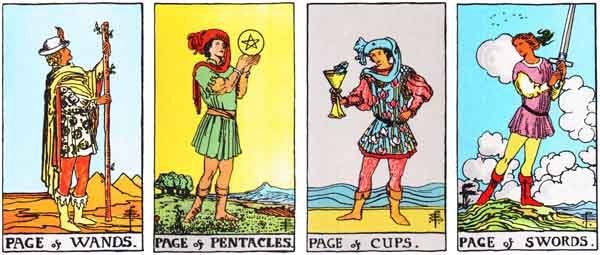 The four Pages of the Tarot, missing in the playing card deck.
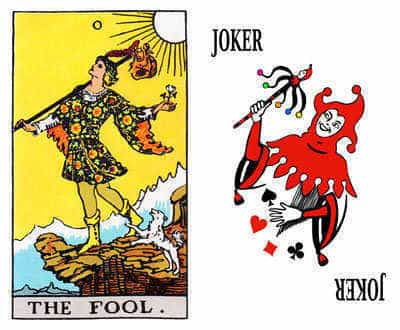 The Fool from the Tarot and the Joker from the playing card deck.
The suits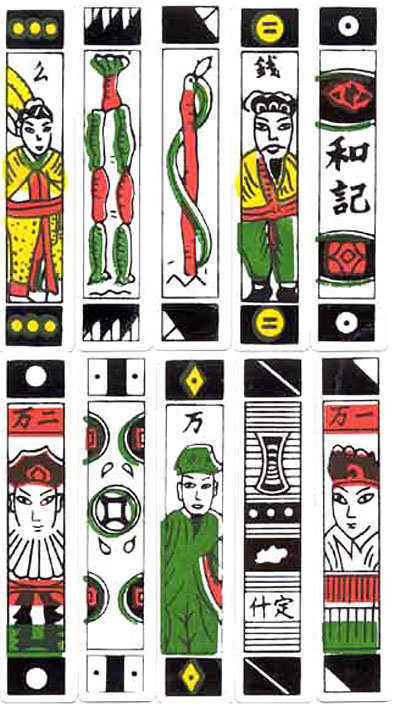 Chinese playing cards.
The European versions, though, have come to spread over other subjects as well, incorporating typical allegorical motifs and themes that can be found in many examples of traditional symbolic thinking. Since there are four suits, they have unavoidably been compared to the four elements of Ancient Greece: fire, earth, air, and water. This cosmological quartet has been of such influence since the time of the Greek philosophers that the suits of the Tarot card deck were made to conform with it. Another influence is that of the four feudal classes: the military (aristocracy), the clergy, the merchants (trade), and the peasants (agriculture).
Wands or Clubs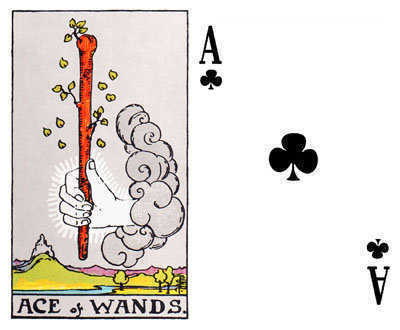 The Tarot Ace of Wands and the Ace of Clubs in the playing card deck. The first of the suits is called Wands in the Tarot, and Clubs in the playing card deck. Of the Greek elements, they represent earth — things concrete and earthbound. The life of the peasant. That might be why it's the suit regarded as the lowest also in many card games. I see in the Wikipedia text on the Minor Arcana that Wands and Clubs are linked to the element fire, which makes no sense at all. It must be a modern modification of the allegorical thinking of the past, made to fit some system or other. There is little, if anything, in the Greek idea of the element fire to support this connection. Wands, as well as agriculture, belong to the element earth.
Pentacles or Diamonds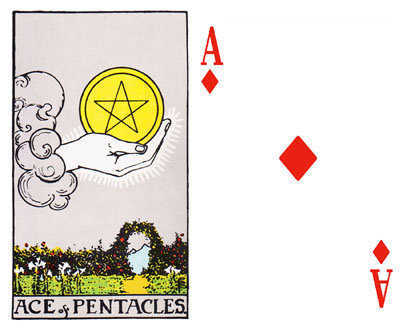 The Tarot Ace of Pentacles and the Ace of Diamonds in the playing card deck. The second suit in the Tarot is that of Pentacles, equivalent to Diamonds of the playing card deck. This suit is the one where the Chinese origin is preserved the most. It's about riches, which is why it's surprising that the suit is not counted as the top one in either Tarot or playing card games. It suggests that the attitudes towards wealth differ between ancient China and Europe. Surely, Christianity has a role in this, since its message is that it's more difficult for the rich to enter Heaven than for the camel to pass through a needle's eye. Wealth is no virtue in the Christian tradition, but it sort of is in Chinese culture, where some regard it as a sign of being in accord with the Way of Heaven and receiving the award for it. The Greek element corresponding to this suit is air, although it takes a bit of a stretch of the imagination. Air is about thought, communication, and mental processes in general. Ideas are jewels, certainly, and without them there is little chance of amassing great fortunes if not inheriting them. But everybody also knows that no fortune is as fortunate as wisdom, so there's the more direct link between the symbolic concepts. Wikipedia, mentioned above, links this suit to the Greek element earth, which makes some sense since money in our eyes is linked to the material world. But that's a modern understanding of riches as well as the element earth. In the past, the latter was closely linked to agriculture, working the soil, and the former was connected to aristocracy and power, since peasants had little chance of ever getting rich. To them, money was almost something imaginary, i.e. more mind than matter. The feudal class connected to this suit is that of trade — the merchants and businessmen in the towns, who were increasingly successful through the centuries in actually getting rich, by the 19th century even surpassing the wealth of the aristocracy.
Cups or Hearts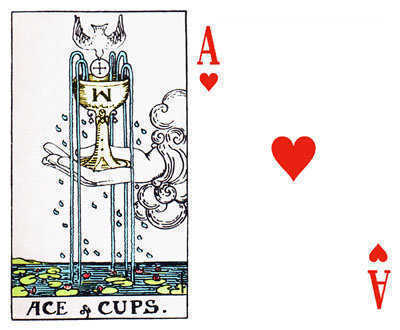 The Tarot Ace of Cups and the Ace of Hearts in the playing card deck. In present day texts on the Tarot, Cups is regarded as the third of the four suits. Its playing card counterpart Hearts, though, counts as the highest of the suits in many card games. That may have to do with the corresponding Greek elements. Cups and Heart resemble the principle of the element water, which is that of emotions. It's not the element usually placed first — although there was a Greek philosopher who stated firmly: panta rei, everything is floating. Since the playing cards have deviated from the symbolism and allegory of divination, they may also have left the order these things mostly have for another one, influenced by Christian thought. Christian influence may have affected the playing cards more than the Tarot, since the latter has been more and more connected to a tradition of mysticism and magic setting itself apart from the Christian dogma. The Hearts represent one feeling in particular, love, and none is higher in the essence of Christianity. That's why this suit is connected to the feudal class of clergy. The church was one of the heart — or should be, at least. Also, the order between the suits in the Minor Arcana of the Tarot is of much less significance than the values assigned to the suits of the playing cards. So, what became necessary to decide with the playing card deck was more or less ignored with the Tarot. In any case, the Cups and the Hearts are all about emotions and their influence, as is the element water.
Swords or Spades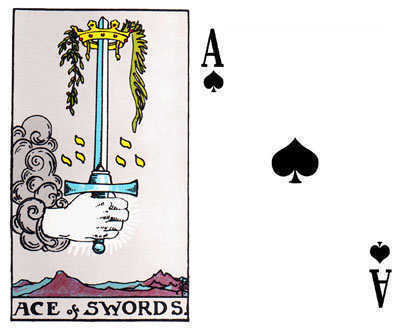 The Tarot Ace of Swords and the Ace of Spades in the playing card deck. The last of the four Tarot suits is that of Swords. Its counterpart in the regular playing card deck is Spades. Although most texts on the Tarot present it as the highest or at least last of the four, in card games Spades is often second to Hearts. As for the heightened value put on Hearts, I've given some thoughts above. When it comes to Swords being the last of the Minor Arcana in the Tarot, an evident explanation would be the sword's connection to aristocracy and power. But there's an additional ingredient, relating to the Greek element. Swords and Spades are connected to the Greek element fire, which stands for activity and pure power. It's the element of the four that's always mentioned first, since it's linked to the vernal equinox, the 21st of March, which was the start of the year in ancient calendars. It's also the moment when the sun enters the Zodiac sign Aries, the cardinal fire sign. So, what's first in one order is last in another, but in both cases signifying its importance. Wikipedia claims this suit to belong to the Greek element air, which may stem from comparing the sword to the principle of justice — like the sword held by Justitia. The principle of law, which is a thing of the mind, as is the element air. But law is made by those in power, and power is definitely closer to the element fire. Traditionally, justice was in the hands of the mighty. It probably still is. So, the idea of it may be air, but the reality of it is fire. And the sword, like any weapon, is very much about reality. So, in Tarot the last and sort of most prominent of the suits is that of Swords, relating to power, principle, and the way of the warrior. In Christian tradition, this type of virtue has been questioned and another has taken its place at the top: that of emotions, primarily love — the Heart suit in the playing card deck. It doesn't matter much that Tarot and playing cards differ at this point, since the Tarot rarely gives significance to any relative value between suits. They stand for different things, simply, in no particular order. The only distinction in value made by the Tarot is between the Minor and the Major Arcana. But that's outside the comparison between Tarot and playing cards, since the latter has no such thing.
Pip and Court Pip cards from the Tarot of Marseille: Pentacles 10 to 5. The Rider-Waite Tarot deck has illustrations for all the 78 cards, both the 22 of the Major Arcana and the 56 of the Minor Arcana. Playing cards, though, only have images for twelve of the 52 cards — the court cards. The remaining 40 pip cards, the Ace to ten of each suit, only have repetitious patterns of their suit symbols. This was probably to facilitate the printing of them, when printing was much more of a hands-on craft. Actually, many Tarot card decks through the centuries have been produced similarly to the playing cards, with rudimentary illustrations for the pip cards. There have been exceptions, ever since the Renaissance, where all the cards were painstakingly hand-painted to hold elaborate images. More common, though, has been the simpler solution still around in the type of deck called the Tarot of Marseille, as well as other designs. Except for the delight of elaborate images on some of the cards, there was probably also a sort of political necessity for making the court cards stand out. Dealing with kings and queens and such, everybody had to show proper respect and admiration. Colorful images for them were mandatory. The court cards also imply that the link between the suits and the four feudal classes is not the dominant one. Peasants were not allowed to have any kings, nor were merchants, whereas the kings of the clergy had other titles completely and nobody would dare to deviate from them. Kings came from the aristocracy, so that was the only class obviously and acceptably linked to royalty. In the imaginations of past minds, the four suits might rather have given an impression of four kingdoms. If so, Cups (Hearts) would have been a sea-faring one, such as an island kingdom. Wands (Clubs) would be an inland realm, thriving on farming. Pentacles (Diamonds) would be a country of commerce, like the city states of Renaissance Italy, trading goods from far away to far away. Swords (Spades) would be a warring state, constantly battling to increase its territory. The above is pure speculation, of course, but such thoughts wouldn't be alien to minds of our past. And it would explain why the pip cards were usually not illustrated. Except for the court, the population of a kingdom was not that important in any other way than its quantity.
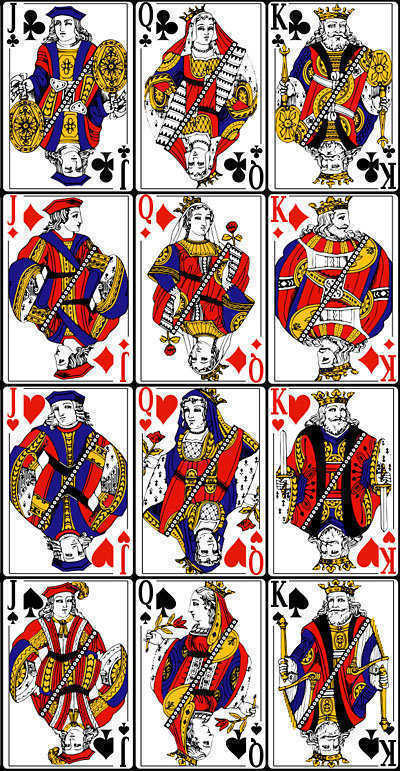 Court cards of a modern playing card deck.
About Cookies
My Other Websites:I Ching OnlineThe 64 hexagrams of the Chinese classic I Ching and what they mean in divination. Free online reading.
Complete HoroscopeHow predictions are done in classical astrology with the full horoscope chart. Many examples.
Creation MythsCreation stories from around the world, and the ancient beliefs about the world and the gods as revealed by the myths.
Other Books of MineClick the image to see the book (and Kindle ebook) at Amazon (paid link).
|
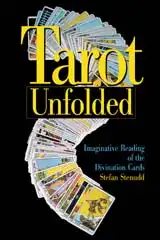 Tarot Unfolded
Tarot Unfolded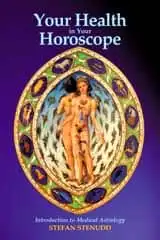


 Stefan Stenudd
Stefan Stenudd